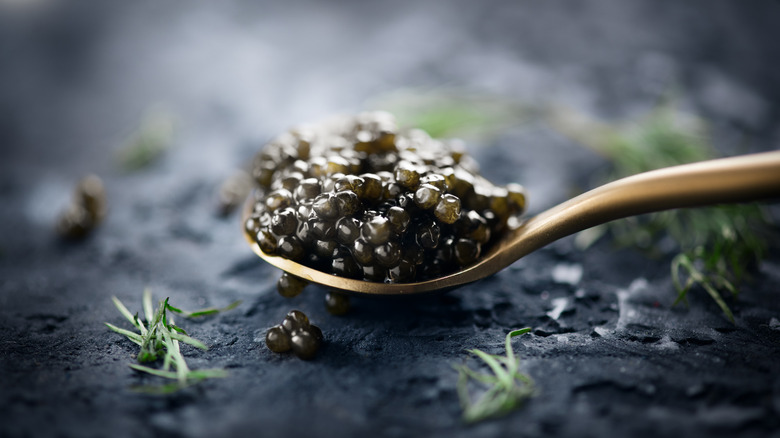Eric Ripert's Favorite Way To Enjoy Caviar Is Beautifully Basic
Eric Ripert is one of the most celebrated chefs of the modern era. More specifically, he is one of the most celebrated chefs who focuses mainly on seafood. Thus, it makes sense that he has a strong stance on how caviar and other fish roe (aka eggs) should be served. Much like the seafood he serves at his Michelin-starred restaurant Le Bernardin, the idea is to let the simple beauty of the ingredient shine through without too much fussy ornamentation.
Caviar is often accompanied by a host of bold and starchy pairings, including blinis, cornichons, hard-boiled eggs, dill, capers, and onions. While these items certainly pair well with the burst of salt and umami that fish eggs deliver, they can, at times, serve to obscure the delicate flavor of the roe. That's why Ripert opts for a more reserved approach when serving caviar.
His preference is for caviar to have but one accoutrement, if any. A simple dollop of crème fraîche — or none at all — is how he preserves the beautiful brininess of caviar, Ripert explains in his cookbook "Seafood Simple." Further, he notes, cooking caviar and other roe is a task to be undertaken with great care. Much like with poultry eggs, a little bit of heat goes a long way, and can result in fish eggs that become hard and overly salty.
The simple beauty of caviar
Caviar is considered one of the fancier foods that gourmands adore, along with foie gras, Wagyu beef, and truffles. It is the eggs of sturgeon, an ancient variety of fish that ply waters around the globe, but generally are harvested in Russia, Iran, and other nations bordering the Black and Caspian Seas. The sacks of eggs are pulled from the bodies of Beluga, Osetra, and Sevruga sturgeon, among others, and cured in salt, originally a preservative but now an integral part of the caviar flavor.
Caviar service has long been mired in haughty tradition meant to exemplify the flavor. At the most finicky level, caviar is meant to be unadulterated, and that means even by serving implements. Metal spoons, which some believe spoil the flavor, are never to be used. In their place, spoons carved from nonreactive mother-of-pearl found inside certain bivalve shells are used to scoop up caviar from tins.
It's only fitting that a fan such as Eric Ripert has his own line of caviar. Farm-raised in Hangzhou, China, this sturgeon roe is described as a nutty and light variety that clocks in north of $700 per 4-ounce tin of Imperial Osetra. But don't go scarfing down gobs of the stuff; Ripert once told Town & Country that his line of caviar is meant to be savored. "It's best experienced with someone you love, in a celebratory mood," the chef explained. "You actually shouldn't have it every day, because then you'd take it for granted."

